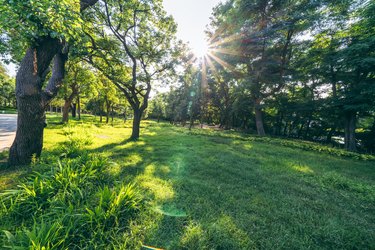
Lime is not a herbicide, so applying lime to kill weeds isn't its primary purpose. That being said, there are various liming agents that can improve your lawn's health and - in doing so - help it to fight weeds on its own. It is crucial to make sure that your soil needs lime prior to application: otherwise, you can actually weaken your lawn and make it more susceptible to weeds.
Types of Lime
Video of the Day
A variety of materials can be used to lime your lawn, some best left to professionals with appropriate safety gear. For home users, dolomitic and ground limestone are both safe-to-apply options that will slowly change the pH of the soil (dolomitic lime provides magnesium as well). Both are typically applied at a rate of 50 lbs. per 1,000 square feet. Pelletized limestone, while more expensive than other types of lime, is easy to apply and works quickly. It is applied at the same rate as dolomitic and ground limestone.
Video of the Day
Burned (slaked) and hydrated lime are more hazardous and, although quick-working, are harder to apply than other types. They must be used at a much lower rate than other types of lime, usually 10 to 20 lbs. per 1,000 square feet.
Benefits of Using Lime

Lime increases soil pH and can improve the health and quality of your lawn. Lawns with a pH below 6.0 are considered very acidic and can benefit from liming. Acidic soils often suffer from a lack of nutrients that your grass needs, including nitrogen, calcium, potassium, phosphorus, sulfur and magnesium. When a lawn lacks nutrients, it fades in color, its growth rate decreases and it is more easily damaged by hot temperatures, drought and foot traffic. A weakened lawn is much more susceptible to weed problems.
While liming does not kill weeds, it does improve your lawn's health by increasing nutrient availability, which can help it maintain strength and fend off weeds on its own.
Applying Lime to Kill Weeds
Before you decide that your lawn needs lime, to compete effectively against weeds, have your local county extension office perform a pH test on your soil; make sure to get a copy of the soil test report, as this will indicate how much lime your lawn needs. If the soil pH is 5.5 or below, add a liming agent at the rate suggested by the soil test report. A single application will be fine if the recommended rate of application is 50 pounds per 1000 square feet or less; if it's higher (meaning your soil is more acidic) you'll need to use multiple applications at least six months apart.
Lime can be applied at any time except when the grass is frosted or wilted. Use a drop or spinner spreader, fill it with lime and spread one application in one direction and crisscross this with a second application to ensure even coverage. If you use ground limestone, it is best to apply it at the end of summer or beginning of fall. Once you've achieved your target pH, most lawns will only need an application of lime once every few years.
When Applying Lime is Appropriate
It is crucial to remember that liming is not necessary for all lawns. Liming a lawn that is already acidic or over-liming can create alkaline soil that lacks necessary nutrients, thus increasing the potential for weeds. For the best results, have an expert perform a soil test rather than doing it on your own so you use the correct amount of lime for your soil.

Remember, using lime to kill weeds is not a direct process like applying a herbicide. Instead of a rapid die-off, you'll see your lawn's grass gradually reassert itself and out-compete the weeds. You can encourage this through other good cultural practices, including frequent mowing and appropriate levels of fertilization.